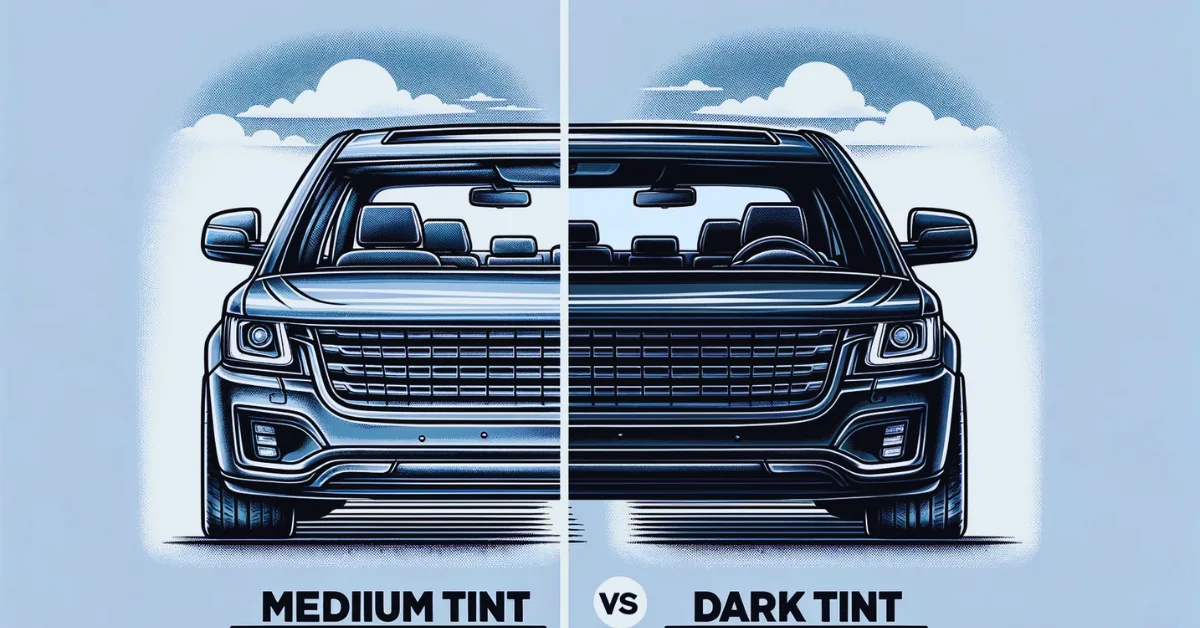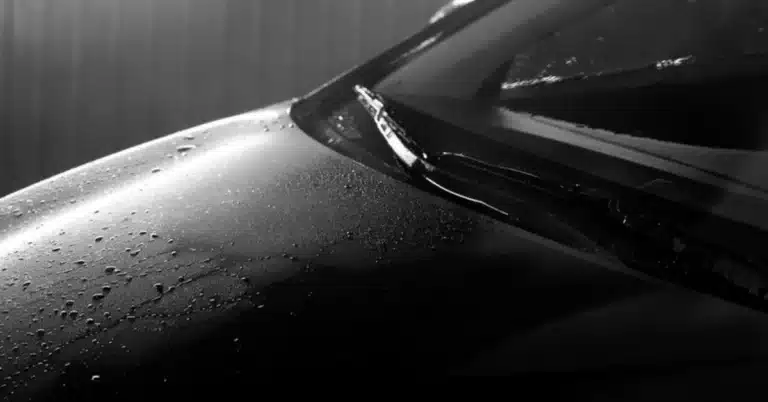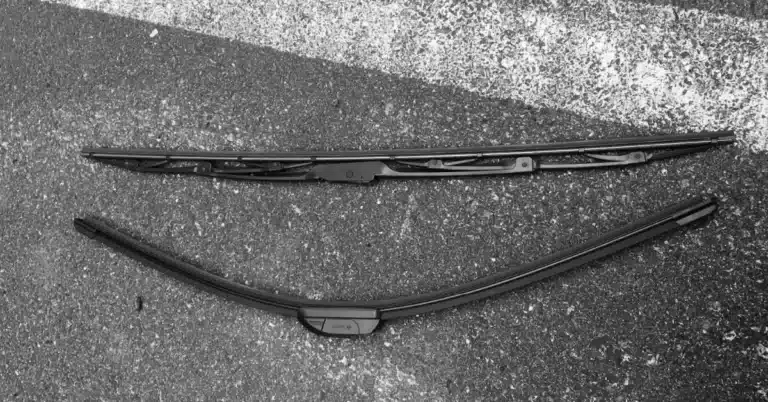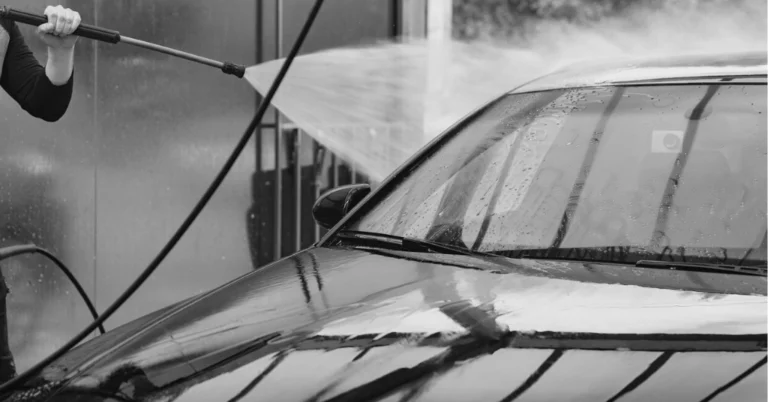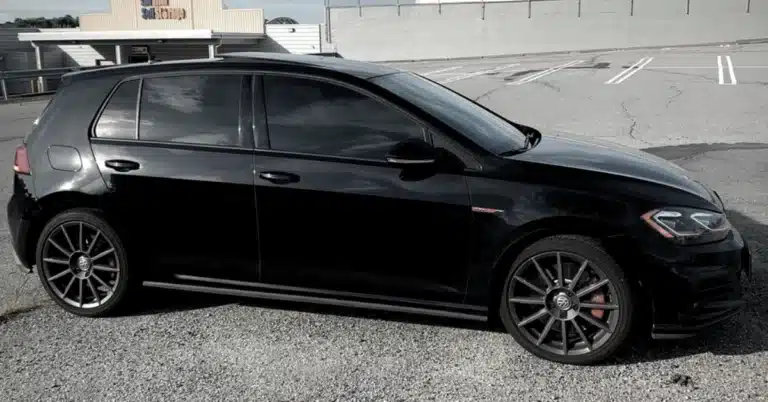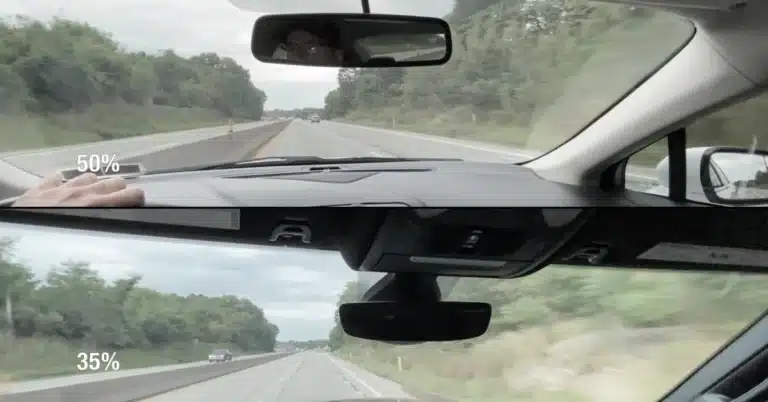My brother, Mark, called me from the garage and asked whether he should install the medium tint or the dark tint on this car window. He was really confused.
Even though both these automotive tints are good options, there are some significant differences between them that help you make a decision.
I have explained to Mark the differences between these tints and also comparing Medium Tint vs. Dark Tint films here for your better understanding.
Go through the comparison carefully before making a buying decision.
Read More: 15% vs. 5% Tint
About Medium Tint
A Medium Tint, more popularly known as the medium window tint, is a type of automotive tint that lets 30%, 35%, or 50% visible light pass through while blocking the remaining.
These tint films are usually moderately dark yet offer incredible privacy and protection to the users. From resisting UV rays and heat to keeping away prying eyes, the comfort and convenience they offer are undeniable.
Also, because of its moderate darkness, Medium Window Tints offer greater visibility for enhanced safety while driving.

About Dark Tint
Also known as the dark window tint film, the Dark Tint is also an automotive window tint that is extremely dark in appearance, as the name suggests.
These tint films usually let just 5% or 20% of the visible light pass through the surface while blocking the remaining.
As it is very dark, the Dark Tint offers the utmost privacy and protection; however, it is illegal in many US regions.
Medium Tint vs. Dark Tint
Medium and Dark automotive window tints have some major differences between them. Even though I have talked about them in detail below, first, go through the summary of the comparison.
It will help you to have a quick idea about how Medium and Dark window tints differ.
| Properties | Medium Tint | Dark Tint |
| Visible Light Transmission | 30%, 35%, 50% | 5%, 20% |
| Darkness | Moderate | Incredibly Dark |
| Privacy | Moderate | Excellent Privacy |
| Visibility | Enhanced Visibility | Reduced Visibility |
| Legal Restrictions | Legal in Most US States | Not Legal In Many US States |
| Price | Affordable | Expensive |
What Are The Differences Between Medium Tint and Dark Tint?
Now that you know how the Medium Tint and Dark Tint differ from one another, go through the detailed explanation below for even better learning.
Visible Light Transmission
The most significant difference between Medium Tint and Dark Tint is in the amount of visible light they let through and how much light they block.
For starters, Medium Tints are usually 30%, 35%, or 50% Tint films that allow 30%, 35%, and 50% of the visible lights to pass through while blocking the others.
As this tint allows such a moderate amount of light to pass through, they are usually less dark. But that doesn’t mean the Medium Tint hamper privacy and protection.
On the other hand, as the name suggests, Dark Tint is extremely dark and usually allows just 5% or 20% of visible lights to pass through.
Because of their darker color, this window tint film provides top-notch privacy and protection to the car cabin.

Visibility
There is a major difference in the visibility of both the Medium Tint and the Dark Tint.
While medium window tints are not as dark, they offer enhanced visibility for a safer drive. These tint films can cut glare significantly so that you can see clearly while driving.
However, the same cannot be said about the Dark Tint. Because these tint films are super dark, they affect the visibility of the driver significantly.
Legal Restrictions
When it comes to legal restrictions, it is a matter of concern for both Medium Tint and Dark Tint.
That’s because, as the medium tint films are moderately dark, they are legal in most of the US states. You just need to check with the local authorities before installing them on the vehicle.
However, Dark Tint is completely illegal. It doesn’t matter in which US state you are in, you just cannot install it on your car because of its extreme darkness.
How dark is medium tint?
The darkness of “medium tint” can vary depending on the context, as it’s a somewhat subjective term.
In the context of automotive window tinting, for example, medium tint typically allows around 30-50% of visible light to pass through the window, offering moderate shading while still providing a reasonable level of visibility from the inside.
However, the exact darkness of a medium tint can vary based on local regulations and personal preferences.
How dark is dark tint?
“Dark tint” is a term used to describe window films or coatings that significantly reduce the amount of visible light that can pass through.
Dark tint typically allows only around 5-20% of visible light to transmit through the window. As a result, it provides substantial shading and privacy, making it a popular choice for those seeking a higher level of sunblock and reduced visibility from the outside.
It’s important to be aware that the legality and acceptable darkness of tint can vary by location, so it’s essential to comply with local regulations when applying window tint to your vehicle or property.
What Andy Thins on Medium Tint vs. Dark Tint
From the Medium Tint vs. Dark Tint comparison, it is very much clear that both these tint films have some significant differences.
Hence, you must be careful while making an installation decision.
My advice would be to install the Medium Tint. That’s because it not only provides protection and privacy, but it’s legal, too. You don’t have to face any authorities for putting on this tint film.
The price of the Medium tint is reasonable as well.

